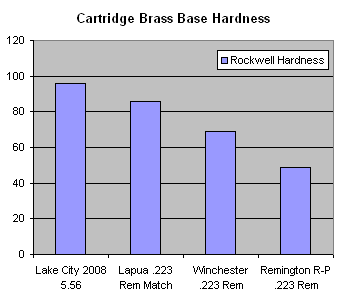1Moose
Well-Known Member
- Joined
- Nov 25, 2013
- Messages
- 168
Hello all,
Working up loads for 260 Remington. 24 inch Chanlynn barrel. Would appreciate any help interpreting if velocity for loads show any concerning pressure signs. First, no cases had any visible signs of pressure. Only the very slightest flattening on just a few primers across all loads, and not corresponding to the highest powder charge (still plenty of roundness to the edges). Not even the faintest extractor marks. No hint of stiff extraction.
Components: Lapua brass. H1000 powder. Rem 9.5 primers. Hornady 143 ELD-X bullets.
Labradar chronograph.
DECEMBER 26 (70*F). These are shots 40 thru 80 (roughly) in new barrel / rifle.
Load 1: 45.6 grains H1000. Jump = 0.050. Velocity avg = 2574.
Load 2: 46.1 grains H1000. Jump = 0.050. Velocity avg = 2596.
Load 4: 47.0 grains H1000. Jump = 0.047. Velocity avg = 2664.
Load 5: 47.8 grains H1000. Jump = 0.028. Velocity avg = 2677.
Load 6: 46.1 grains H1000. Jump = 0.156. Velocity avg = 2609.
JANUARY 20 (42*F). Tried three seating depths based off of 47.8 grains as that had tightest group earlier)
Load 7: 47.8 grains H1000. Jump = 0.010. Velocity avg = 2764.
Load 8: 47.8 grains H1000. Jump = 0.028. Velocity avg = 2759.
Load 9: 47.8 grains H1000. Jump = 0.033. Velocity avg = 2754.
Questions:
Q1) I've heard of velocity increases in first 150 rounds of barrel. First time I've had a chronograph to observe it myself. Even with lower temperatures in second outting, Load 8 is 82 fps higher than Load 5. <same load, a few more rounds down barrel, lower temp). Seem normal?
Q2) In Loads 7-9, I'm seeing approximately 150 fps higher than the Hornady manual's listed velocity. Again, no pressure signs. Maybe I have a faster than normal barrel? Have heard of +/- 100 fps not being uncommon. Granted, Hornady doesn't give many increments for powder and velocity for the 260 Remington, so I may not actually be that much higher than book if they showed more detail. (They show a lot more detail for Creedmoor for far more powders--likely given their affinity for their own cartridge). And I'm closer to lands and have longer overall cartridge length (2.820 vs 2.800) so less gas is escaping around the bullet I assume before it engages rifling.
Q3) Load 5 didn't show much velocity increase from Load 4, despite the powder increase. Should I assume this is a concerning sign? Max book load is 49.6 grains H1000 @ 2700 fps listed. Note that some load groups only recorded velocity for 2 shots given chrono position, so sample size isn't large.
Any thoughts could be useful as I haven't had benefit of chronometer for load development, so learning how to interpret things.
Working up loads for 260 Remington. 24 inch Chanlynn barrel. Would appreciate any help interpreting if velocity for loads show any concerning pressure signs. First, no cases had any visible signs of pressure. Only the very slightest flattening on just a few primers across all loads, and not corresponding to the highest powder charge (still plenty of roundness to the edges). Not even the faintest extractor marks. No hint of stiff extraction.
Components: Lapua brass. H1000 powder. Rem 9.5 primers. Hornady 143 ELD-X bullets.
Labradar chronograph.
DECEMBER 26 (70*F). These are shots 40 thru 80 (roughly) in new barrel / rifle.
Load 1: 45.6 grains H1000. Jump = 0.050. Velocity avg = 2574.
Load 2: 46.1 grains H1000. Jump = 0.050. Velocity avg = 2596.
Load 4: 47.0 grains H1000. Jump = 0.047. Velocity avg = 2664.
Load 5: 47.8 grains H1000. Jump = 0.028. Velocity avg = 2677.
Load 6: 46.1 grains H1000. Jump = 0.156. Velocity avg = 2609.
JANUARY 20 (42*F). Tried three seating depths based off of 47.8 grains as that had tightest group earlier)
Load 7: 47.8 grains H1000. Jump = 0.010. Velocity avg = 2764.
Load 8: 47.8 grains H1000. Jump = 0.028. Velocity avg = 2759.
Load 9: 47.8 grains H1000. Jump = 0.033. Velocity avg = 2754.
Questions:
Q1) I've heard of velocity increases in first 150 rounds of barrel. First time I've had a chronograph to observe it myself. Even with lower temperatures in second outting, Load 8 is 82 fps higher than Load 5. <same load, a few more rounds down barrel, lower temp). Seem normal?
Q2) In Loads 7-9, I'm seeing approximately 150 fps higher than the Hornady manual's listed velocity. Again, no pressure signs. Maybe I have a faster than normal barrel? Have heard of +/- 100 fps not being uncommon. Granted, Hornady doesn't give many increments for powder and velocity for the 260 Remington, so I may not actually be that much higher than book if they showed more detail. (They show a lot more detail for Creedmoor for far more powders--likely given their affinity for their own cartridge). And I'm closer to lands and have longer overall cartridge length (2.820 vs 2.800) so less gas is escaping around the bullet I assume before it engages rifling.
Q3) Load 5 didn't show much velocity increase from Load 4, despite the powder increase. Should I assume this is a concerning sign? Max book load is 49.6 grains H1000 @ 2700 fps listed. Note that some load groups only recorded velocity for 2 shots given chrono position, so sample size isn't large.
Any thoughts could be useful as I haven't had benefit of chronometer for load development, so learning how to interpret things.
Last edited:



